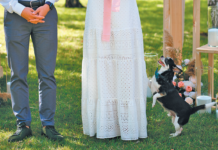Q I have a smallish mutt — 26 pounds — who is active for her size but probably not as active as many bigger dogs. That said, I have fallen in love with a 70-pound Lab who needs a home, and I would like it to be mine. But I worry that the two dogs won’t be simpatico in terms of their needs for physical activity, and I don’t have the time to take them out separately. What do you think?
Michaela Borovoi
Fullerton, California
Dear Ms. Borovoi,
A Different dogs do have different exercise needs, so you’re right to plug that variable into the equation. But the answer is not always that small dogs need less physical activity than larger ones. Any dog between 20 and 50 pounds is actually considered “medium,” and within that category there are all ranges of activity needs. Some medium dogs on the small side can happily go for miles, while there are plenty of larger dogs, like greyhounds, for instance, who are content to lie around much of the day, despite their amazing speed.
Age plays into it, too. Granted, Labs tend to like to be pretty active, but an older Lab is going to romp less than a younger one, so you want to throw the age of the two dogs into the mix.
Even if the Lab who has stolen your heart is much more active than the dog you already have, there’s a better-than-even chance that you’ll be able to accommodate both of them on outings. For instance, the Lab may run back and forth to you 100 times during a single walk off leash, while the little one may stick closer to your side, thereby covering much less ground during the time you’re outside. Both will be happy with the amount of activity they choose.
Of course, if you pair a one-year-old hunting dog with a 10-year-old bichon, yes, you may run into trouble accommodating both of them. But many times, the two-dog scenario is much more down the middle than that.
With that in mind, we think that while considering exercise needs is a good idea on your part, it’s at least as important, if not more, to think about such things as the two dogs’ temperaments and whether, given the fact that your smaller dog has had your home and your love to herself for a while, she would want to share resources and affection. Many do — even if they don’t at first. But some dogs would rather remain “only children.”
It would be great if you could arrange a sleepover that lasts at least three to five nights. That would give you time to take an educated guess about whether your current canine pal would like same-species company. Sometimes, a dog is excited about the prospect of having another dog around but soon tires of it. Other times, two dogs don’t get along off the bat but then settle their differences and can’t imagine how they ever lived without each other.
Good luck making your decision. Physical activity needs are important to consider, but taking a look to see if the two animals want to be “siblings” in general will help you make the best decision.




